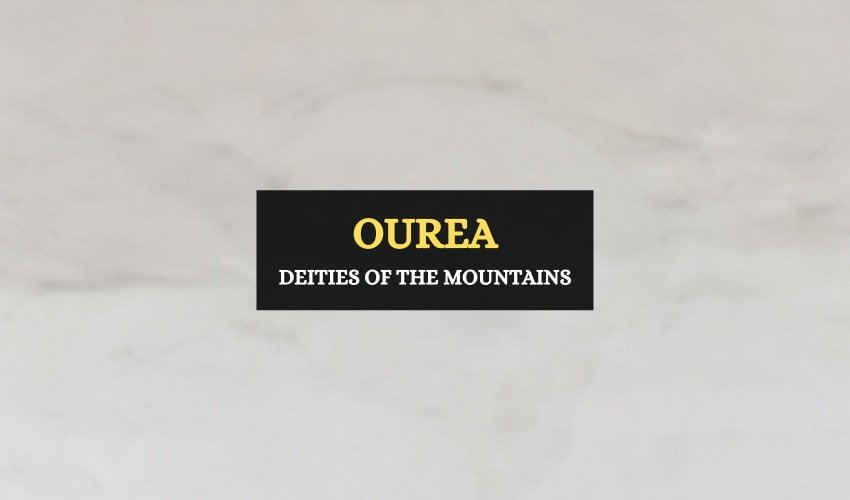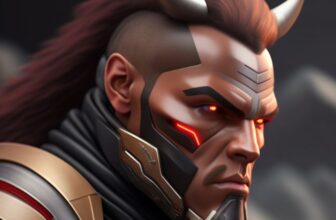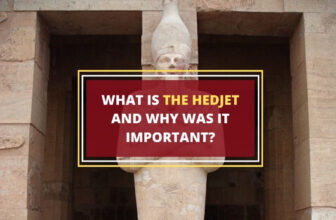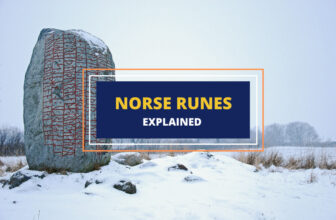
Table of Contents
In Greek mythology, each mountain was believed to have its own deity. The Ourea were the primordial deities that represented the mountains of the world known to ancient Greeks. They were the children of Gaea—the personification of the Earth as a goddess, and the mother of almost all other gods of the Greek pantheon. The Ourea are also known by their Roman name Montes, and commonly referred to as Protogenoi, meaning first beings, as they were among the primordial deities of the pantheon.
According to Greek mythology, there was only Chaos or primeval emptiness of the universe since the beginning of time. From this Chaos, came Gaea the Earth, along with Tartarus, the underworld, and Eros, love and desire.
Then, Gaea gave birth to the ten Ourea—Aitna, Athos, Helikon, Kithairon, Nysos, Olympus of Thessalia, Olympus of Phrygia, Oreios, Parnes and Tmolus—along with Ouranos, the sky, and Pontos, the sea.
The Ourea are rarely mentioned and personified, but they’re sometimes depicted as gods rising from their peaks. In classical literature, they were first mentioned in Hesiod’s Theogony, around 8th century BCE. In Argonautica by Apollonius Rhodius, they were briefly mentioned when Orpheus sang of creation. Here’s what to know about the significance of each mountain deities in ancient Greek and Roman texts, and mythology.
List of Ourea
1- Aitna
Also spelled Aetna, Aitna was the goddess of the Mount Etna in Sicily, southern Italy. Sometimes referred to as a Sicilian nymph, she decided between Hephaestus and Demeter when they quarreled regarding the possession of the land. By Hephaestus, she became the mother of the Palici, the twin demi-gods of hot springs and geysers.
Mount Etna was famed for being the place of Hephaestus’ flaming workshops, as the smoke from the volcano was thought to be the evidence of work being undertaken. Since the volcano was very active during the classical era of Rome, the Romans also adapted the idea for Vulcan, the Roman god of fire. It was the place where Hephaestus and the Cyclopes made the thunderbolts for Zeus.
In Pindar’s Pythian Ode, Mount Etna was the place where Zeus buried the monster Typhon. The poem also describes Aitna hurling her fires beneath, while her summit reaches the height of heaven. Some interpretation says that it was the monster who breathed out fire and flames toward the heavens, and his restless turnings were the cause of earthquakes and lava flows.
2- Athos
In classical literature, Athos was the mountain god of Thrace, north of Greece. In one myth, Athos was named after one of the Gigantes who tried to storm the heavens. He threw a mountain at Zeus, but the Olympian god made it fall down near the Macedonian coast, where it became Mount Athos.
In Geographika by Strabo, the first century Greek geographer, it’s mentioned that there was a proposal to fashion the mountain in the likeness of Alexander the Great, as well as to make two cities on the mountain—one on the right and the other on the left, with a river flowing from one to the other.
3- Helikon
Also spelled Helicon, Helikon was the Ourea of the highest mountain of Boeotia in central Greece. The mountain was sacred to the Muses, the goddesses of human inspirations who preside over different kinds of poetry. At the foot of the mountain, the fountains of Aganippe and Hippocrene were located, which were said to be connected by Helikon’s harmonious stream.
In The Metamorphoses of Antoninus Liberalis, Helikon was the place where the Muses and the Pierides had a musical competition. When the Muses sang, the mountain was captivated by it and swelled toward the sky until the winged horse Pegasus struck its summit with his hoof. In another myth, Helikon participated in a singing competition with the neighboring mountain, Mount Kithairon.
4- Kithairon
Also spelled Cithaeron, Kithairon was the other mountain god of Boeotia in central Greece. His mountain spanned the borders of Boeotia, Megaris and Attica. In a 5th-century BCE Greek lyric, Mount Kithairon and Mount Helikon competed in a singing contest. Kithairon’s song told of how the infant Zeus was hidden from Cronos, so he won the contest. Helikon was gripped by cruel anguish, so he tore out a rock and the mountain trembled.
In Homer’s Epigrams VI, Kithairon presided over the mock wedding of Zeus and Plataea, daughter of the river god Asopos. It all started when Hera was angry with Zeus, so Kithairon advised him to have a wooden statue and dress it up to resemble Plataea. Zeus followed his advice, so when he was in his chariot with his pretend bride, Hera appeared on the scene and tore the dress from the statue. She was pleased to find out that it was a statue and not a bride, so she reconciled with Zeus.
5- Nysos
The Ourea of Mount Nysa, Nysos was entrusted by Zeus with the care of the infant god Dionysus. He was probably the same as Silenus, the foster father of Dionysus, and the wise old man who knew both past and future.
However, no exact location for Mount Nysa was ever given. It was sometimes identified with Mount Kithairon, as its southern valleys, also known as the Nysaian fields, were the place of the abduction of Persephone in the Homeric Hymns.
In Fabulae by Hyginus, Dionysus was leading his army into India, so he temporarily gave his authority to Nysus. When Dionysus came back, Nysus was unwilling to return the kingdom. After three years, he tricked Dionysus foster father by introducing him to soldiers disguised in women’s dress and capturing him.
6- Olympus of Thessaly
Olympus was the Ourea of the Mount Olympus, the home of the Olympian gods. The mountain stretches along the border between Thessaly and Macedonia, near the Aegean coast. It’s the place where the gods lived, feasted on ambrosia and nectar, and listened to Apollo’s lyre.
At first, Mount Olympus was believed to be a mountain top, but eventually it became a mysterious region far above the mountains of the earth. In Iliad, Zeus talks to the gods from the topmost peak of the mountain. He also says that if he wanted to, he could hang the earth and sea from the top of Olympus.
7- Olympus of Phrygia
Not to be confused with the Thessalian mountain of the same name, the Phrygian Mount Olympus is located in Anatolia, and is sometimes referred to as the Mysian Olympus. The Ourea of Olympus was not famous, but he was the inventor of the flute. In mythology, he was the father of the flute-playing satyrs, whose appearance resembled rams or goats.
In the Bibliotheca of Pseudo-Apollodorus, Olympus was referred to as the father of the Marsyas, legendary Greek figure of Anatolian origin. In Ovid’s Metamorphoses, the satyr Marsyas challenged the god Apollo to a musical contest. Unfortunately, the victory was awarded to Apollo, so the satyr was flayed alive—and Olympus, along with other nymphs and deities, was in tears.
8- Oreios
Also spelled Oreus, Oreios was the mountain god of Mount Othrys in central Greece. It’s located in the northeastern part of Phthiotis and southern part of Magnesia. In Deipnosophistae by Athenaeus, Oreios was the father of Oxylos, the demi-god of mountain forests, and Hamadryas, the oak tree nymph.
9- Parnes
Parnes was the Ourea of a mountain between Boeotia and Attica in central Greece. In Homer’s Epigrams VI, he was personified in the texts, along with Kithairon and Helikon. In Ovid’s Heroides, Panes was briefly mentioned in the story of Artemis and the hunter Hippolytus.
10- Tmolus
Tmolus was the Ourea of the mountain of Lydia in Anatolia. In the Metamorphoses by Ovid, he’s described as a steep and high mountain gazing across the sea, facing Sardis on one side and Hypaepa on the other. He was also the judge of a musical contest between Apollo and Marsyas or Pan.
The fertility deity Pan sang his songs and made music on his rustic reed, and even dared to boast Apollo’s music second to his own. In Fabulae by Pseudo-Hyginus, Tmolus gave the victory to Apollo, even if Midas said that it should rather have been given to Marsyas.
FAQs About the Ourea
Ourea refers to a group of primordial deities, rather than a single deity. They are the gods of the mountains.
The Ourea are the offspring of Gaea.
The name Ourea can be translated as mountains.
In Brief
Primordial deities in Greek mythology, the Ourea were a group of mountain gods. In classical literature, they’re known by their names Aitna, Athos, Helikon, Kithairon, Nysos, Olympus of Thessalia, Olympus of Phrygia, Oreios, Parnes and Tmolus. They represent the mountains that were known to ancient Greeks, including the Mount Olympus. As firstborn gods who emerged in the beginning of the universe, they remain a significant part of their mythology.








